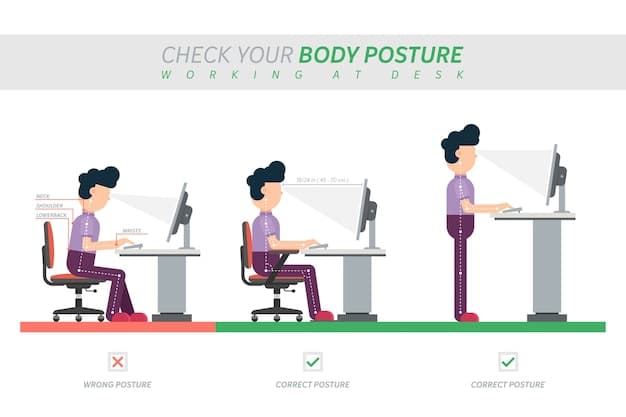Improve Posture in 30 Days: Ergonomic Excellence Guide

Advertisements
Improving your posture in 30 days is an achievable goal through consistent ergonomic adjustments, mindful movement, and targeted strengthening exercises that collectively enhance spinal alignment and reduce musculoskeletal strain.
Embarking on a journey to improve your posture in 30 days: a step-by-step guide to ergonomic excellence is more than just an aesthetic pursuit; it’s a foundational commitment to your overall health and longevity. Poor posture, a silent epidemic in our increasingly sedentary world, can contribute to chronic pain, reduced mobility, and even impact mood and concentration. This comprehensive guide unveils a practical, month-long roadmap designed to progressively realign your body, strengthen key supporting muscles, and cultivate lasting habits for optimal ergonomic living. By meticulously detailing daily actions and providing actionable insights, we aim not only to correct current postural imbalances but also to empower you with the knowledge to maintain a resilient and pain-free posture for years to come.
Understanding the Foundation: Why Posture Matters and How It’s Shaped
Before diving into corrective exercises and ergonomic adjustments, it’s crucial to grasp the profound significance of good posture and the myriad factors that subtly, yet powerfully, shape it. Posture isn’t merely about standing tall; it’s the position in which you hold your body upright against gravity while performing various activities, whether sitting, standing, or lying down. Our bodies are complex, interconnected systems, and when one part is out of alignment, it can create a cascade of compensatory issues throughout the entire musculoskeletal framework. This intricate balance is influenced by a confluence of habits, environmental factors, and even our emotional states.
The impact of poor posture extends far beyond superficial appearances. Chronic slouching or forward head posture can exert undue pressure on the spine, leading to muscle imbalances, nerve compression, and degenerative changes over time. Headaches, neck pain, back pain, and even digestive issues can often be traced back to persistent postural deviations. Conversely, good posture facilitates efficient movement, reduces joint stress, and optimizes breathing mechanics, leading to increased energy levels and improved athletic performance. It also projects an image of confidence and competence, influencing how others perceive us and, importantly, how we perceive ourselves.
Common Postural Deviations and Their Roots
Several common postural deviations plague modern society, often stemming from prolonged periods in static positions, repetitive movements, or a lack of awareness. Recognizing these patterns is the first step toward correction.
- Forward Head Posture: Often seen in individuals who spend extensive time on computers or smartphones, where the head juts forward, placing increased strain on the neck and upper back.
- Rounded Shoulders (Kyphosis): Characterized by an exaggerated forward curve in the upper back, frequently a result of prolonged sitting, sedentary lifestyles, and weak back muscles.
- Anterior Pelvic Tilt: Where the pelvis tilts forward, causing an exaggerated curve in the lower back (lordosis) and often leading to tight hip flexors and weak glutes and abdominals.
Each of these deviations creates a unique set of stresses on the body. For instance, for every inch your head moves forward, it adds approximately ten pounds of pressure on your neck, transforming what should be a balanced load into a significant burden. This understanding underscores the urgent need for a systematic approach to postural correction, focusing not just on symptoms but on addressing the underlying causes through a holistic strategy.
Ultimately, our posture is a reflection of our daily habits. From the way we work at a desk to how we carry our bags, every action contributes to the sum total of our postural alignment. By identifying and consciously adjusting these habits, we can begin to retrain our bodies and build a stronger, more resilient foundation for ergonomic excellence.
Week 1: Awareness and Initial Adjustments
The first week of your 30-day posture challenge is dedicated to building foundational awareness and implementing immediate, impactful changes. Without truly understanding your current postural habits, sustainable improvement remains elusive. This phase is about cultivating mindfulness regarding your body’s positioning throughout the day and making small, yet significant, environmental adjustments. It sets the stage for the more intensive work that will follow, ensuring your immediate surroundings support your long-term goals.
Begin by observing your posture in various situations. How do you sit at your desk? How do you stand in line at the grocery store? Pay attention to the subtle cues your body sends, such as discomfort in your neck, shoulders, or lower back. Many of us adopt positions that feel comfortable in the short term but lead to strain over prolonged periods. This week is about breaking free from unconscious patterns and consciously choosing better alignment.

Ergonomic Workspace Optimization
For many, a significant portion of the day is spent at a desk. Optimizing your workspace is paramount for postural improvement. Even minor adjustments can make a substantial difference in reducing strain and promoting better alignment.
- Monitor Height and Distance: Position your monitor so the top of the screen is at eye level, about an arm’s length away. This prevents neck strain from looking down or upward.
- Chair Setup: Ensure your chair provides good lumbar support. Your feet should be flat on the floor, or supported by a footrest, with your knees at a 90-degree angle. The chair should allow you to sit close enough to your desk that your arms are supported and your elbows are at about 90-100 degrees when typing.
- Keyboard and Mouse Placement: Keep your keyboard and mouse close to your body to avoid reaching, which can strain your shoulders and wrists. Consider an ergonomic keyboard and mouse if you experience discomfort.
While perfecting your setup, remember that even a perfect ergonomic workstation cannot counteract the effects of prolonged static posturing. Integrate movement breaks into your routine every 30-60 minutes, even if it’s just standing up, stretching, or walking a few steps. This helps to alleviate pressure and improves circulation, preventing the stiffness and fatigue often associated with long periods of sitting.
Beyond the workspace, apply this newfound awareness to other daily activities. When standing, distribute your weight evenly, with your shoulders relaxed and back, and your core gently engaged. When lifting objects, bend from your knees, not your back. These small, consistent efforts during week one will begin to retrain your body and mind, paving the way for more significant changes in the weeks to come. This initial phase is about building a strong mental and physical foundation, acknowledging that every conscious adjustment, no matter how small, contributes to your overarching goal of ergonomic excellence.
Week 2: Active Strengthening and Mobility
Once you’ve established a foundation of awareness and initial ergonomic adjustments in Week 1, Week 2 shifts focus towards active strengthening and mobility exercises. Passive adjustments alone are insufficient for lasting postural change; the body needs to be strong enough to hold itself in correct alignment. This phase introduces targeted exercises designed to address common muscular imbalances that contribute to poor posture, fostering strength in key stabilizing muscles and improving overall flexibility. The goal is to build the muscular endurance necessary to maintain good posture effortlessly throughout your day.
The emphasis this week is on consistency and proper form over intensity. Start with a manageable number of repetitions and gradually increase as your strength improves. Listen to your body and avoid movements that cause pain. The exercises chosen for this week are specifically designed to counteract the effects of prolonged sitting and modern lifestyles, strengthening the back, glutes, and core, while gently stretching tight chest and hip flexor muscles.
Essential Strengthening Exercises for Posture
Incorporating a routine of specific exercises will directly combat slouching and imbalances. Aim to perform these exercises daily or at least five times a week.
- Chin Tucks: Lie on your back or sit upright. Gently pull your chin back, as if making a double chin, without tilting your head down. Hold for 5 seconds, release. Repeat 10-15 times. This strengthens deep neck flexors and reverses forward head posture.
- Scapular Squeezes (Wall Angels/Pecs Stretches): Stand with your back against a wall, feet shoulder-width apart. Try to flatten your lower back against the wall. Bring your arms up to a “W” shape, then slowly slide them up the wall, keeping your elbows and wrists in contact if possible, until they form a “Y.” Reverse the movement. Repeat 10-15 times. This strengthens the mid-back and stretches the chest.
- Glute Bridges: Lie on your back with knees bent and feet flat on the floor, hip-width apart. Engage your glutes and lift your hips off the floor until your body forms a straight line from shoulders to knees. Hold for 2-3 seconds, then slowly lower. Repeat 10-15 times. Strong glutes support the pelvis and lower back.
- Plank: Start in a push-up position, then lower onto your forearms, keeping your body in a straight line from head to heels. Engage your core, avoiding sagging hips or raising them too high. Hold for 30-60 seconds, or as long as you can maintain good form. Repeat 2-3 times. This is excellent for core stability.
Beyond these targeted strength exercises, gentle mobility work for the thoracic spine (upper back) and hips is also crucial. Cat-cow stretches, thoracic rotations, and hip flexor stretches can significantly improve range of motion and reduce stiffness, complementing the strengthening efforts. Remember that muscles work in pairs; strengthening one group often requires lengthening its opposing group. For example, as you strengthen your back muscles, gently stretching your chest muscles becomes equally important to allow for full range of motion.
By the end of Week 2, you should start to feel a noticeable difference in your ability to maintain better posture for longer periods. Your body will begin to adapt to these new, stronger demands, making it less effortful to sit or stand correctly. This active intervention is pivotal in transforming temporary adjustments into sustainable ergonomic excellence, building the internal strength required to support your new, improved alignment.
Week 3: Habit Integration and Advanced Awareness
As you enter Week 3, the focus shifts from introducing new exercises to integrating improved posture into every facet of your daily life and deepening your awareness. You’ve built a foundational understanding and started strengthening key muscle groups. Now, the challenge is to make good posture an intuitive habit rather than a conscious effort. This week is about applying what you’ve learned to less obvious situations and actively combating “postural drift” – the tendency to revert to old habits when not actively thinking about it.
This phase demands consistent self-monitoring. Set periodic reminders on your phone or computer to do a “posture check.” This could be an hourly reminder to stand up, roll your shoulders back, and engage your core. The more frequently you bring conscious awareness to your posture, the faster it will become an automatic reflex. Think of it as retraining your internal posture alarm system, making it more sensitive to deviations from ideal alignment.
Applying Postural Principles Beyond the Desk
Good posture isn’t confined to sitting or standing ergonomically. It extends to how you move, carry objects, and even relax. This week, expand your focus to activities that might unknowingly contribute to poor posture.
- Walking Posture: Stand tall, with your head level and looking straight ahead, not down at your feet. Shoulders relaxed and slightly back. Engage your core gently. Let your arms swing naturally. Avoid slouching or hunching forward.
- Sleeping Posture: The best sleeping positions for spinal alignment are on your back or side. If on your back, use a pillow that supports the natural curve of your neck. If on your side, place a pillow between your knees to keep your hips, pelvis, and spine aligned. Avoid sleeping on your stomach, as it often forces your head to turn to one side, straining your neck.
- Lifting and Carrying: When lifting heavy objects, squat down using your legs, keeping your back straight and the object close to your body. When carrying bags or backpacks, distribute weight evenly. Use both straps for backpacks and alternate shoulders for bags.
- Driving Posture: Adjust your car seat to support your lumbar curve. Ensure your knees are slightly bent and your feet can comfortably reach the pedals. Adjust the steering wheel so your arms are slightly bent, not locked, and your shoulders are relaxed.
Beyond physical adjustments, consider the role of stress and fatigue. When we are stressed or tired, our bodies often revert to slouching as a protective mechanism or simply due to lack of energy to maintain proper alignment. Incorporate stress-reduction techniques like deep breathing, short meditation breaks, or gentle stretching into your day. Ensuring adequate sleep also provides your body with the recovery it needs to sustain strong postural muscles.
Moreover, begin to identify your personal “postural triggers.” Do you slouch when reading on the couch? Do your shoulders hunch when you’re concentrating intently? Recognizing these specific scenarios allows you to proactively adjust and solidify your new habits. By the close of Week 3, maintaining good posture should feel less like a chore and more like a natural, comfortable state, a testament to your consistent effort in cultivating advanced awareness and integrating these principles across all daily activities.
Week 4: Maintenance, Refinement, and Long-Term Strategies
As you enter Week 4, you’ve completed the intensive phase of your posture transformation. This final week is dedicated to consolidating your progress, refining your understanding, and establishing sustainable long-term strategies. The goal is to move beyond conscious effort and embed ergonomic excellence into your lifestyle, making good posture an intrinsic part of your identity. This phase acknowledges that posture is not a static destination but an ongoing journey of mindful maintenance and continuous improvement.
Reflect on the progress you’ve made. How has your pain decreased? How has your energy level improved? Celebrating these victories reinforces positive habits and motivates continued effort. This week, instead of introducing entirely new concepts, we focus on deepening the existing ones and exploring how to future-proof your postural well-being against the challenges of daily life. It’s about building resilience and flexibility in your approach, ensuring that minor setbacks don’t derail your overall progress.
Integrating Posture into a Holistic Wellness Routine
Maintaining excellent posture goes hand-in-hand with overall wellness. Consider how complementary practices can support your postural health in the long run.
- Regular Exercise: Beyond specific posture exercises, engage in a balanced exercise routine that includes cardiovascular fitness, strength training (targeting all major muscle groups, not just those directly related to posture), and flexibility work. Yoga and Pilates, in particular, are excellent for core strength, body awareness, and flexibility, all crucial for sustained good posture.
- Mindfulness and Body Scans: Continue to practice daily body scans, even for just a few minutes. Lie down or sit comfortably and systematically bring your awareness to different parts of your body, noticing any tension or misalignment. This practice enhances proprioception (your body’s sense of its position in space), making you more attuned to subtle postural shifts.
- Hydration and Nutrition: Adequate hydration helps maintain the disc health in your spine, while nutrient-rich foods support muscle health and reduce inflammation. A balanced diet contributes to overall vitality, making it easier for your body to sustain optimal alignment.
- Professional Check-ins: Consider occasional consultations with a physical therapist, chiropractor, or ergonomic specialist if you experience persistent pain or wish to further refine your posture. They can provide personalized advice and identify imbalances that require specific interventions.
One of the biggest challenges in maintaining good posture is avoiding complacency. Life happens, and it’s easy to slip back into old habits, especially during periods of stress or increased workload. Develop strategies to counteract this: perhaps a “reset” routine you perform at the start of each day, or a commitment to daily stretching. Your 30-day challenge successfully initiated significant changes, but the true triumph lies in making these changes permanent. By embracing posture as an ongoing, integral component of your wellness routine, you ensure that the benefits you’ve cultivated over the past month continue to enhance your health, confidence, and overall quality of life for years to come. This final week is your launchpad for a lifetime of ergonomic excellence and a more resilient, well-aligned body.
Understanding Postural Pain and When to Seek Professional Help
While many postural issues can be significantly improved through self-correction and consistent effort, it’s crucial to understand the nuances of postural pain and recognize when professional medical intervention becomes necessary. Not all pain is merely a symptom of “bad posture”; some may indicate underlying conditions that require specialized diagnosis and treatment. Distinguishing between general discomfort and more serious issues is key to effective and safe management of your postural health journey.
Mild aches and stiffness, particularly when starting a new posture correction regimen, are often normal. These sensations typically arise as muscles adapt to new positions and strains are redistributed throughout the body. They should generally subside within a few days or weeks as your body strengthens and adjusts. However, certain types of pain or persistent symptoms warrant a closer look by a healthcare professional.
Signs Indicating Professional Consultation
It’s important to differentiate between temporary discomfort and potential warning signs. Pay close attention to these symptoms:
- Persistent or Worsening Pain: If pain in your neck, back, or shoulders is constant, severe, or gets worse despite your efforts to improve posture and relieve pressure.
- Numbness or Tingling: Radiating pain, numbness, or tingling sensations in your arms, legs, hands, or feet often suggest nerve compression, which requires immediate medical evaluation.
- Weakness: If you experience muscle weakness in any limb that affects your ability to move or perform daily tasks.
- Loss of Bladder or Bowel Control: This is a medical emergency that could indicate severe spinal cord compression and requires immediate attention.
- Pain that Disrupts Sleep: If discomfort is so severe that it prevents you from sleeping soundly or wakes you up at night.
- Unexplained Weight Loss or Fever: These systemic symptoms, when accompanying back or neck pain, could indicate a more serious underlying condition.
Conditions such as herniated discs, spinal stenosis, scoliosis, or degenerative disc disease can mimic simple postural pain but require specific diagnostic testing and treatment plans. A physical therapist, chiropractor, orthopedist, or primary care physician can provide an accurate diagnosis. They can offer tailored exercise programs, manual therapy, or, if necessary, discuss medical interventions. Waiting too long to seek help for these types of symptoms can lead to more complex problems and prolonged recovery times.
Even in the absence of severe symptoms, a professional assessment can be beneficial. A physical therapist, for example, can conduct a thorough postural analysis, identify specific muscle weaknesses or tightness that you might not be aware of, and prescribe a highly personalized exercise regimen. They can also provide guidance on ergonomic setup and movement patterns specific to your occupation and lifestyle. By understanding when to seek expert advice, you ensure that your journey towards ergonomic excellence is both effective and safely managed, addressing any underlying issues that could impede your progress.
Building a Future of Ergonomic Excellence: Beyond 30 Days
Your 30-day journey to improve posture is a significant milestone, but it’s essential to recognize that achieving and maintaining ergonomic excellence is an ongoing commitment, not a singular destination. The habits and strength you’ve cultivated over the past month are powerful foundations, yet they require continuous nurturing to withstand the demands of modern life. This concluding phase emphasizes the long-game, offering strategies to solidify your gains and proactively prevent regression, ensuring your body remains aligned, strong, and pain-free for years to come.
Think of posture improvement as a journey of continuous refinement. Just as you maintain other aspects of your health through regular exercise and healthy eating, posture demands consistent attention. Life circumstances change – new jobs, different activity levels, aging – and your approach to posture must adapt accordingly. Establishing a flexible, sustainable routine that fits into your daily life is paramount for long-term success, allowing you to fluidly adjust to new challenges without compromising your gains.
Long-Term Strategies for Sustained Postural Health
To keep your posture strong and resilient, integrate these strategies into your lifestyle beyond the initial 30 days:
- Routine Maintenance: Dedicate a few minutes daily to your posture exercises and stretches. This doesn’t have to be a full workout; even 5-10 minutes of chin tucks, scapular squeezes, and gentle stretches can make a significant difference. Consider morning or evening routines to embed these practices.
- Vary Your Positions: Avoid prolonged static positions, even ergonomically correct ones. If you sit for long periods, stand up and stretch every 30-60 minutes. If you stand, shift your weight, or take short walking breaks. Varying your posture distributes stress and prevents muscular fatigue.
- Invest in Supportive Gear (Wisely): While not a cure-all, ergonomic chairs, standing desks, and supportive footwear can aid in maintaining good posture, especially during repetitive or prolonged activities. Ensure any investment aligns with your body’s specific needs and encourages dynamic movement rather than passive support.
- Listen to Your Body: Be attentive to early signs of discomfort or stiffness. These are often your body’s warnings that you’re reverting to old habits or stressing certain areas. Address these signs promptly with a quick stretch, a posture check, or a change in activity, before they escalate into chronic pain.
- Continuous Learning: Stay informed about best practices in ergonomics and body mechanics. Attend workshops, read reputable articles, and consider periodic check-ups with a physical therapist to identify any developing imbalances.
The commitment to ergonomic excellence is a commitment to your overall well-being. Good posture affects not just your physical health but also your energy levels, confidence, and ability to engage actively with the world. By consistently applying the principles learned over these 30 days and embracing a proactive, adaptive approach to your postural health, you empower yourself to live with greater comfort, strength, and vitality. This is not just about standing taller today, but about building a robust and resilient body for all your tomorrows, ensuring that the benefits of your dedication truly last a lifetime.
| Key Posture Point | Brief Description |
|---|---|
| 💡 Awareness & Ergonomics | Consciously observe daily habits and optimize your primary workspaces for better alignment. |
| 💪 Strengthen & Mobilize | Actively perform targeted exercises to strengthen core, back, and glutes; improve flexibility. |
| 🗓️ Habit Integration | Apply good posture principles to all activities, making it an automatic, consistent habit. |
| ✨ Long-Term Wellness | Maintain focus on overall health, professional check-ins, and continuous refinement for lasting well-being. |
Frequently Asked Questions About Posture Improvement
▼
Noticeable improvements can often be felt within the first week, especially in reduced discomfort. Visible changes in posture typically become apparent by the end of the 30-day program, provided consistent effort. Long-term results depend on integrating these practices into your daily life permanently.
▼
For many, improving posture significantly alleviates chronic back pain stemming from muscle imbalances or spinal strain. Consistent practice can correct root causes of discomfort. However, if pain persists or worsens, consult a healthcare professional to rule out underlying medical conditions.
▼
No, many effective posture exercises and adjustments can be done without any special equipment, using just your body weight and awareness. While ergonomic chairs or standing desks can be beneficial, they are not strictly necessary for starting your posture improvement journey. Focus on consistent effort with what you have.
▼
Absolutely. Slouching or rounded shoulders restrict the expansion of your rib cage and diaphragm, leading to shallow breathing. Improved posture opens up the chest cavity, allowing your lungs to expand fully, thereby increasing oxygen intake and promoting more efficient respiration. Deeper breathing can also reduce stress.
▼
Forgetting is normal initially. Set regular reminders on your phone or computer, or use visual cues like sticky notes at your workspace. Consistent self-correction gradually makes good posture more natural. Over time, your body will instinctively adopt better alignment, reducing the need for constant conscious effort.
Conclusion
The 30-day journey to improving your posture is a transformative experience, offering not just aesthetic benefits but profound enhancements to your physical and mental well-being. By diligently following a step-by-step guide to ergonomic excellence, you embark on a path toward reduced pain, increased energy, and a more confident self-presentation. This guide has provided a comprehensive roadmap, emphasizing the importance of awareness, consistent strengthening, and the integration of new habits into every aspect of your daily life. Remember, this is a commitment to yourself, a continuous journey of refinement and conscious maintenance that will empower you to stand taller, feel better, and live a life unburdened by the stresses of poor alignment. Your body is a remarkable machine; nurture it with the posture it deserves.






